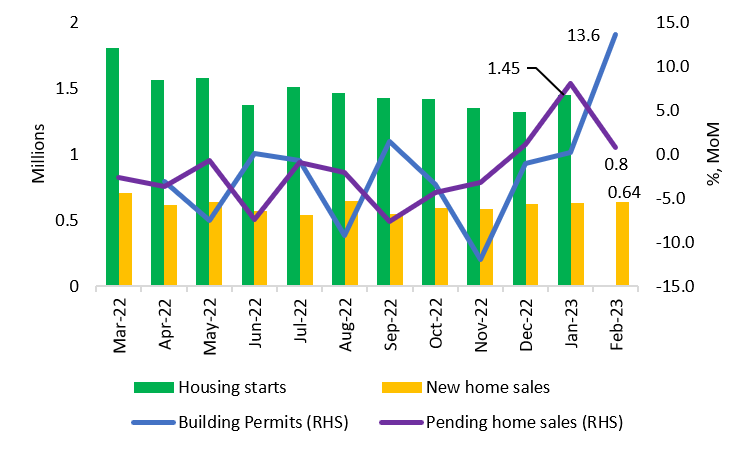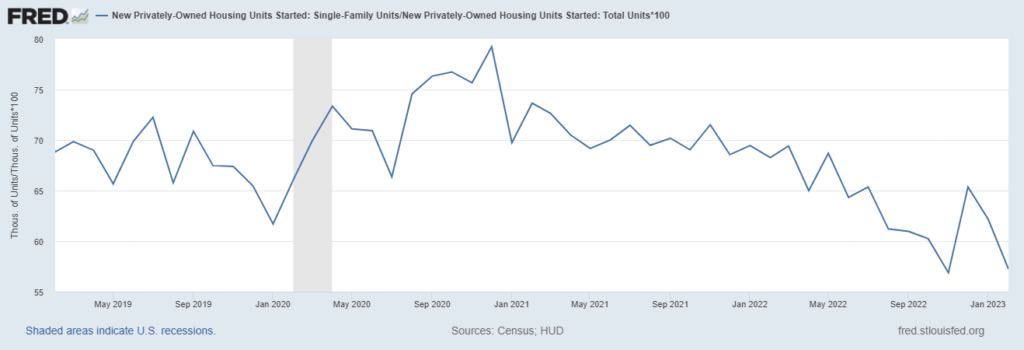Economics
US housing data signals an improvement in lumber demand
Housing data released yesterday provided a welcome boost to the real estate market with pending home sales rising 0.8% MoM to mark a third consecutive…


Housing data released yesterday provided a welcome boost to the real estate market with pending home sales rising 0.8% MoM to mark a third consecutive increase, against estimates of a -2.3% contraction.
Earlier in the month, crucially, total starts rose 9.8% to 1.45 million against 1.32 million in the previous month.
Building permits, a key leading indicator of construction activity, benefited from easing mortgage rates and surged 13.6% MoM in January 2023 to reach 1.55 million compared to an average of 1.34 million in the previous month.
This followed January’s explosive 8.1% performance, which suggests that home sales may improve in the coming months as the market looks to move past the housing contraction of 2022.

With borrowing costs coming off their peak in October and November 2022, buyer interest picked up, even as monetary policy continued to tighten.
As measured by Freddie Mac, average 30-year mortgage rates topped 7%, before easing to 6.09% at the beginning of February 2023.
Initially, elevated rates weighed on single-family home sales, which were subdued from September to November 2022 averaging 573,000 per month.
The reduction in mortgage rates led to three months of improvement, reaching 640,000 in February 2023.
In March 2023, the NAHB/Wells Fargo homebuilder sentiment gauge ticked higher to 44, indicating a sustained improvement in market conditions.
This was the highest level since September 2022, and well above the December 2022 low of 31.
The residential real estate sector may be entering a sustained uptrend, but the Fed’s inflation agenda and the recent banking turmoil continue to cloud the outlook.
North America’s lumber market
An estimate by the National Association of Home Builders found that 90% of US homes continue to be built with wood.
Rising concerns regarding shorter harvest seasons, weaker tree strength, weather damage and fire hazards, have ushered wood alternatives and non-flammable materials into the mainstream but have not done much to dissuade the traditional homeowner.
In the graph below, random length lumber futures (CME: LB1) peaked amid the pandemic above $1,600 levels in mid-2021 and then surged again in early 2022 to above $1,400.

The 3x rise in 2021 futures followed suspended production on expectations of lower demand and stalled deliveries.
Prices continued to fluctuate sharply, falling to $400-territory in between the two peaks.
Despite the heady highs of 2022, lumber futures were down a gut-wrenching two-thirds on the full year.
Since closing at a high of $1,441 in February-end 2022, prices have been in a prolonged slump, giving up 74.0% of their value at the time of writing.
The downward spiral has been led primarily by aggressive hikes in the Fed’s benchmark interest rates, elevated mortgage rates, dwindling buyer power and supply chain repair.
Residential sector factors
The improvement in permits, the renewed uptrend in builder sentiment and the approach of the spring season are all a welcome relief to the lumber industry after the disruptively frigid winters in much of North America.
Thus, construction demand should be lifted at least in the near term.
Recently, single-family starts which are much more wood intensive compared to multi-family homes have fallen to the 57.2% of total starts, nearing the November 2022 low of 56.8%, which was the lowest proportion since 1982.
This dilution in single-family constructions may have kept lumber demand relatively suppressed compared to total starts.

However, the trajectory of the single-family housing component may now be turning around, with Madison’s Lumber Report noting,
… (single-family housing starts) rose +1.1% to a rate of 830,000 units from January’s downwardly revised 821,000 units.
Key considerations
Near-term housing demand will likely rise but will be capped by the unwillingness of homeowners who borrowed at more favourable terms to switch to costlier funding, and due to the limited availability of housing stock, which touched its lowest level since April 2022.
The improvement in underlying residential sector data may help improve demand and stabilize lumber futures in the near term.
The outlook for lumber futures through 2023 will depend heavily on the interest rate and dollar trajectory as well.
Even though the Fed continues to focus on fighting inflation, banking turmoil, economic weakness and mounting debt payments suggest that monetary conditions may have to be eased sooner rather than later.
If rates were to come down, mortgage burdens would ease, making housing more affordable and in turn spurring lumber demand and a bullish trends in other commodities.
However, if the banking system were to show renewed signs of contagion or economic growth were to slow much more than expected, this could weigh on both housing activity and lumber futures.
On the other hand, if the Fed does indeed maintain its stated rate pathway, construction activity, the housing sector and lumber futures will continue to face resistance in the coming months.
In the near term, a third consideration would be the behaviour of managed money funds in the futures market.
Market participants will continue to be in a wait-and-watch mode to assess the Fed’s cycle exit strategy, housing sector robustness and banking sector stress.
The post US housing data signals an improvement in lumber demand appeared first on Invezz.
dollar
inflation
commodities
monetary
policy
interest rates
fed
monetary policy

Argentina Is One of the Most Regulated Countries in the World
In the coming days and weeks, we can expect further, far‐reaching reform proposals that will go through the Argentine congress.
Crypto, Crude, & Crap Stocks Rally As Yield Curve Steepens, Rate-Cut Hopes Soar
Crypto, Crude, & Crap Stocks Rally As Yield Curve Steepens, Rate-Cut Hopes Soar
A weird week of macro data – strong jobless claims but…
Fed Pivot: A Blend of Confidence and Folly
Fed Pivot: Charting a New Course in Economic Strategy Dec 22, 2023 Introduction In the dynamic world of economics, the Federal Reserve, the central bank…















